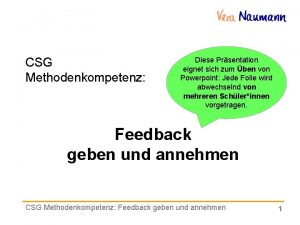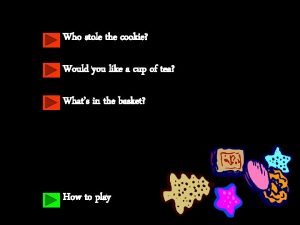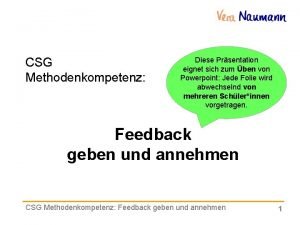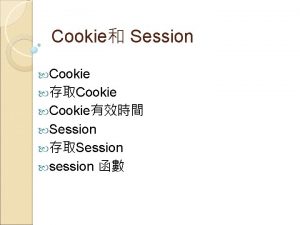Team Cookie Adam Jansons ajansonsuoregon edu John Gershenson








- Slides: 8

Team Cookie Adam Jansons - ajansons@uoregon. edu John Gershenson - jkgershe@mtu. edu Bob Podlasek bpod@bradley. edu Tom Huston tom. huston@uc. edu Christopher Chermside-Scabbo ccherms@wustl. edu Susan Cooper scooper 2@uoregon. edu Nick Capaldini nkc@uoregon. edu

Seven Elements The class is voluntary 2) Students create a physical artifact 3) Student work is motivated by a real problem 4) Students apply broad perspectives to their work 5) An open process is applied to create solutions 6) The course environment contains an interdisciplinary mix of students 7) The number of students in the class is small

Brainstorm (list all ways are/might use) ● Students provide broad perspectives ● not many students allowed in business classes ● human centered design ● business model canvas ● everything is open for discussion ● class number 15 -45 ● voluntary class (elective)

Brainstorm (list all ways are/might use) Issues with complete voluntariness: Buy in when you get busy Might flake out Hackathon! E&I for Chemistry grad students

Pain Points Making the problems “real” - get a client (either real or to speak to class) - blow stuff up - look for community projects (1, 000 cups) How do you find out if students think the problem is “real”? - just ask ‘em! - listen to what they say - brief survey - do brainstorming in class

Pain Points, continued Suggestions for interdisciplinary - College level courses (rather than department level) - Have a lower-credit version that people can add on - Bring in skill set from outside the university (not students being interdisciplinary- all Mech. E students plus a hired EE for example) - Have students role play as a different perspective

Pain Points Making the problems “real” - get a client (either real or to speak to class) - blow stuff up - look for community projects (1, 000 cups) How do you find out if students think the problem is “real”? - just ask ‘em! - listen to what they say - brief survey - do brainstorming in class

Pain Points Suggestions for interdisciplinary - College level courses (rather than department level) - Have a lower-credit version that people can add on - Bring in skill set from outside the university (not students being interdisciplinary- all Mech. E students plus a hired EE for example) - Have students role play as a different perspective - Internships / co-ops - Open the course, let other students in! - THIS IS DIFFICULT















